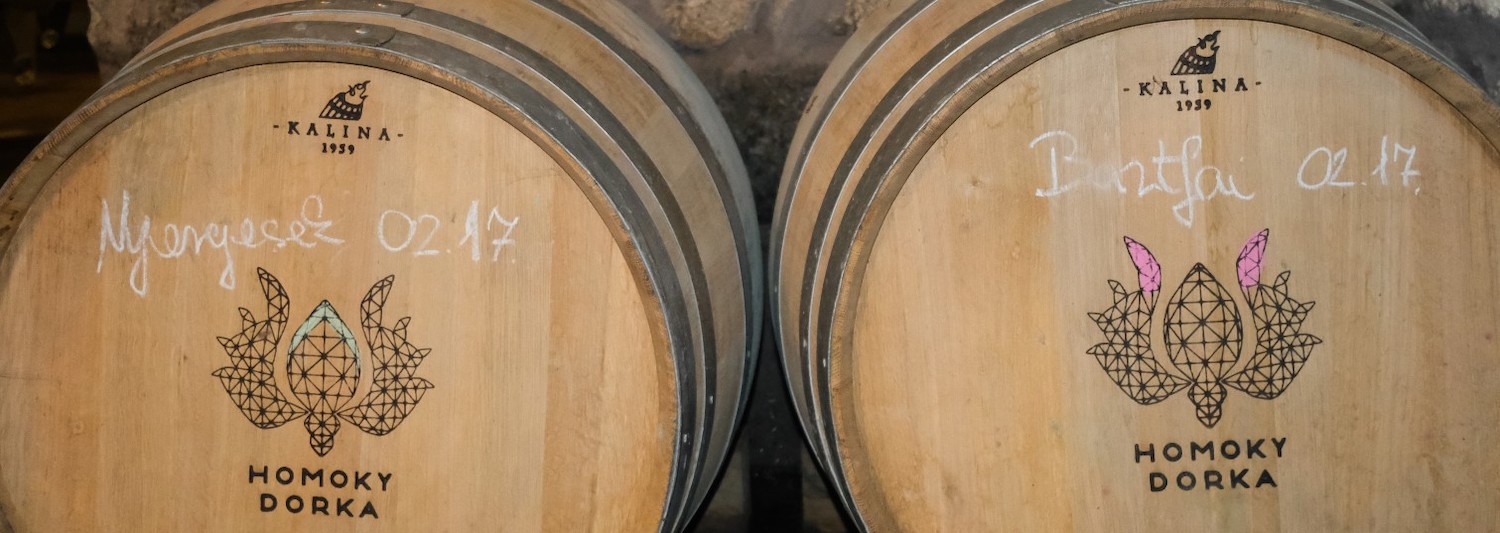

Homoky Dorka, Tokaj, Hungary
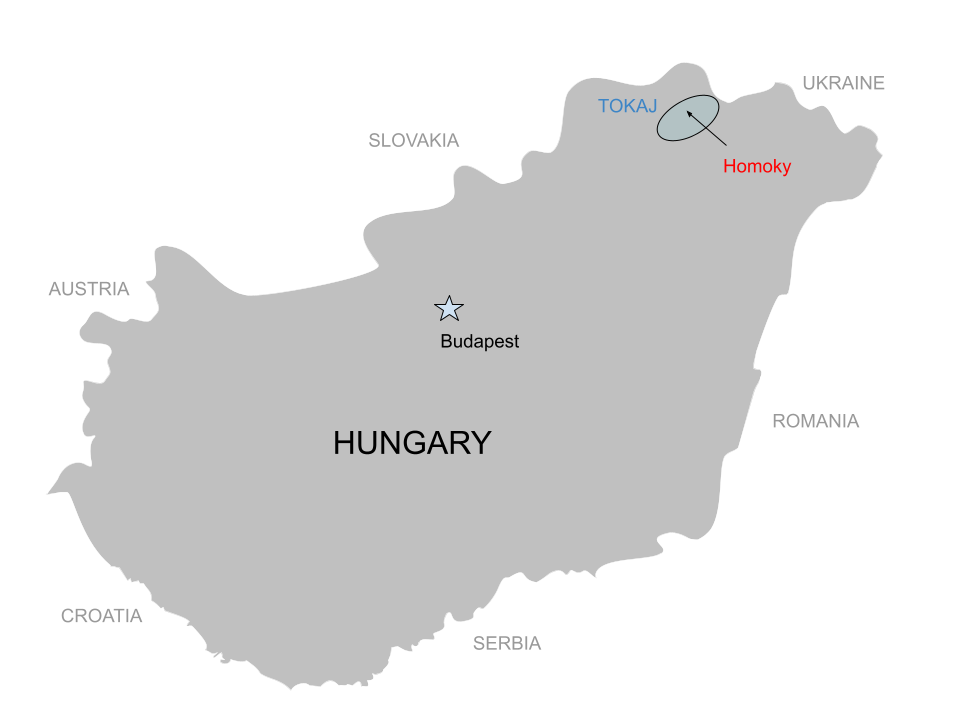
At a Glance
homokydorka.hu
Tokaj
Cool Continental
Rhyolite tuff, andesit, loess, clay
90-200m
Low hills and landscapes of vines and forests
Furmint, Hárslevelű, Sárga Muskotály
3 hectares
Certified Organic
Natural
Tokaj
Cool Continental
Rhyolite tuff, andesit, loess, clay
90-200m
Low hills and landscapes of vines and forests
Furmint, Hárslevelű, Sárga Muskotály
3 hectares
Certified Organic
Natural
Starting with just 1 hectare, Dorka's parent’s rules were simple: You must harvest it. You must make it. You must sell it.

Dorka Homoky in the vineyard
Dorka represents yet another dynamic generation coming of age in Tokaj. She’s among the first to grow up in an established community of female mentors as well. Just within our portfolio, people like Judit Bodó (Bott Pince), Sarolta Bárdos (Tokaj Nobilis) and Stéphanie Berecz (Kikelet) have all been hugely influential just to name a few. This generation also has a vested interest in the younger generation building upon their efforts and continuing to inject vitality and growth into the appellation as a whole. Dorka is also pushing the envelope in terms of low intervention winemaking, organic farming, extended skin macerations, mixing grapes and fruit, and helping pioneer new sparkling wines. Quantities are extremely limited as this is still a very nascent project, but we are confident it will slowly grow into something that fits our needs. This isn’t the first time we’ve witnessed this kind of phenomenon in Tokaj over the past decade.
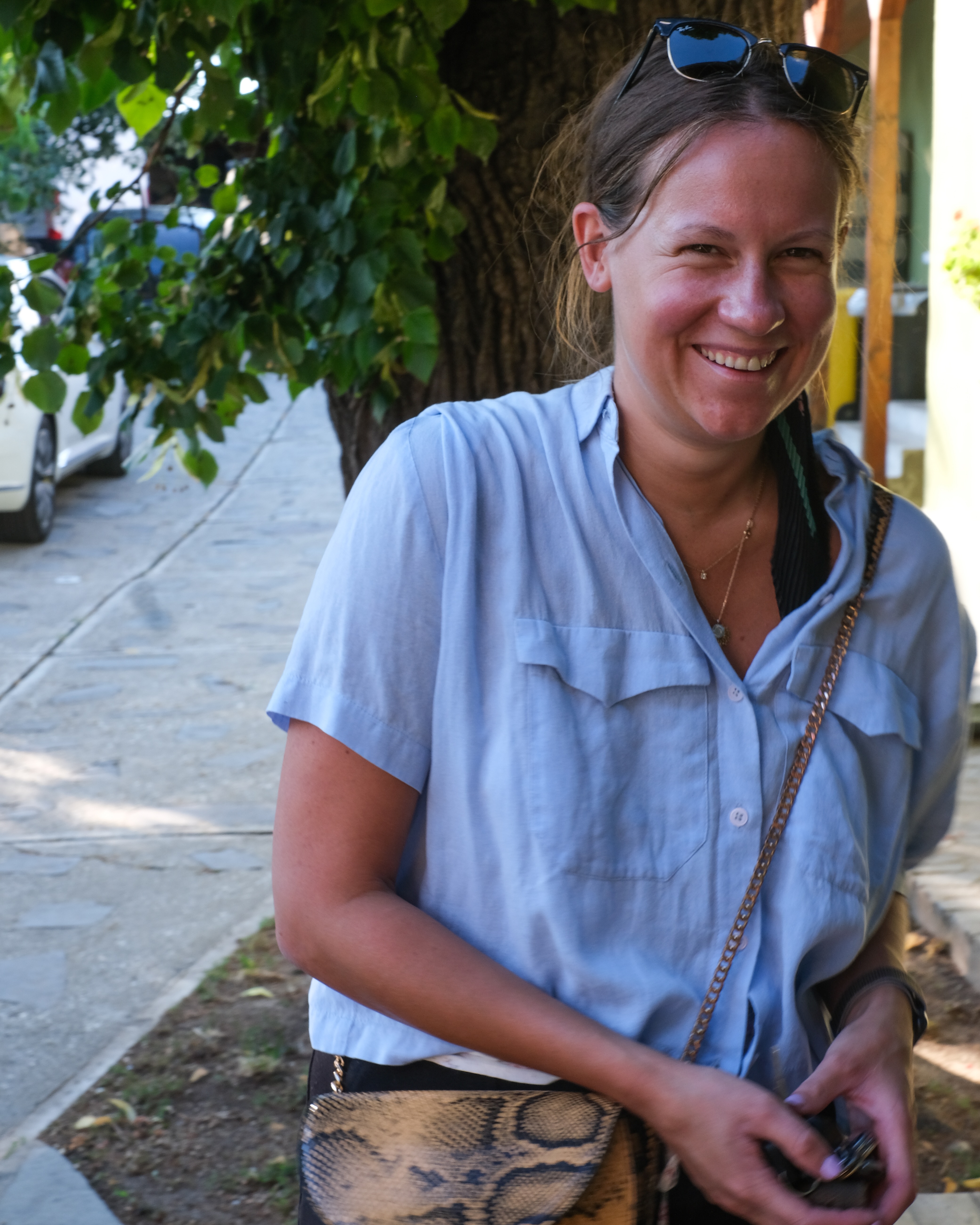
Dorka Homoky

Dorka Homoky
The People
Dorka is a fourth generation winemaker in the village of Tállya in the southwest corner of Tokaj. Her Grandmother managed the vineyards and sold to the COOP during Communism and her parents restarted commercial production during the early re-privatization period. While vineyards, wine on the table and cellars were ubiquitous during her childhood, she never considered wine a career.
Her first degrees were in film and philosophy and most of her time was spent in Budapest. Her parents never pressured her to enter the wine business and they supported her other interests. However, the years away from Tokaj gave her the distance and change in perspective she needed. She started to experiment in the vineyard and cellar bit by bit. In 2016 she made the leap and spent half a year studying viticulture in Lyon where she was also exposed to natural wines followed by a harvest in New Zealand.

Harvesting in the vineyard
She feels beyond lucky to not only return home to an iconic wine region, but also to her family’s experience, traditions, and support. At this point, her contribution to the family is her enthusiasm, relentless energy, and the perspective of having left to see how truly special this slice of Hungary is. Starting with just 1 hectare, her parent’s rules were simple: You must harvest it. You must make it. You must sell it.
Her first degrees were in film and philosophy and most of her time was spent in Budapest. Her parents never pressured her to enter the wine business and they supported her other interests. However, the years away from Tokaj gave her the distance and change in perspective she needed. She started to experiment in the vineyard and cellar bit by bit. In 2016 she made the leap and spent half a year studying viticulture in Lyon where she was also exposed to natural wines followed by a harvest in New Zealand.

Harvesting in the vineyard
She feels beyond lucky to not only return home to an iconic wine region, but also to her family’s experience, traditions, and support. At this point, her contribution to the family is her enthusiasm, relentless energy, and the perspective of having left to see how truly special this slice of Hungary is. Starting with just 1 hectare, her parent’s rules were simple: You must harvest it. You must make it. You must sell it.
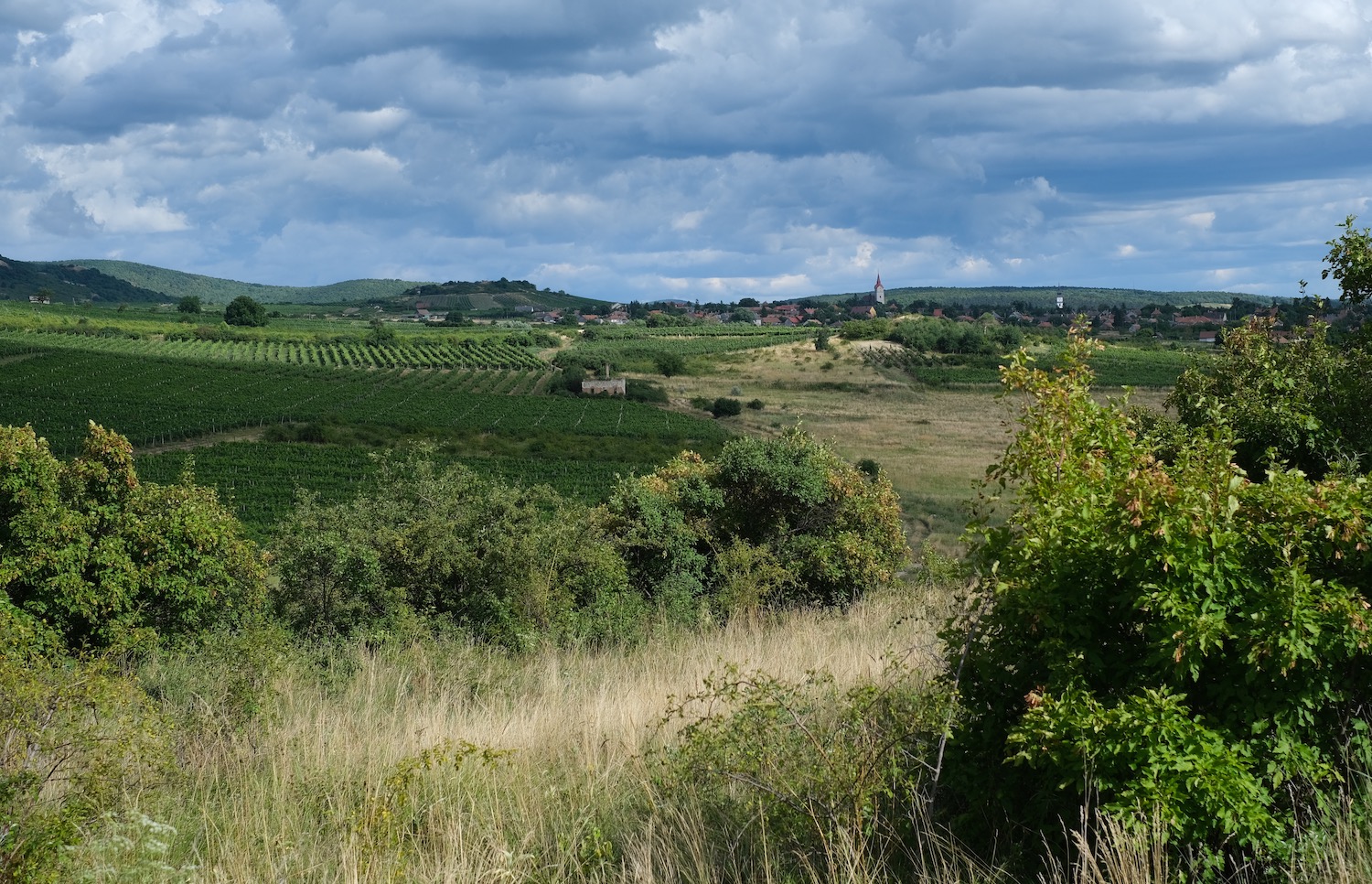
Looking toward Tállya with Dongó on the left
Vineyards
Dorka has since increased to 3 hectares spread across the single vineyards (dűlő) of Hetény, Dongó, Görbe, Bártfai, Sas alja, and Nyergesek. While 300+ years ago Tállya was one of the largest villages in Tokaj and arguably boasted the majority of 1st class sites, today it’s not nearly as developed as other villages, has less than 2000 inhabitants, and only a couple of restaurants. Nevertheless, it’s becoming an incubator for organic farming, there is land available for sale, and a community of like minded growers taking root and helping one another. Tállya is also generally windy and further from the Bodrog River than many other villages, but humidity (namely black rot) can still be an issue. While botrytis at the right time is welcomed, there’s a constant dance between having a lighter canopy to promote airflow and too little risking sunburn. This is especially the case when converting to organics.
Like the rest of Tokaj, the soils here are heavily volcanic. In this southwestern corner of the appellation, andesite dominates many of the sites along with ryholite and a few pockets or loess typically only found around the villages of Tokaj and Tarcal.
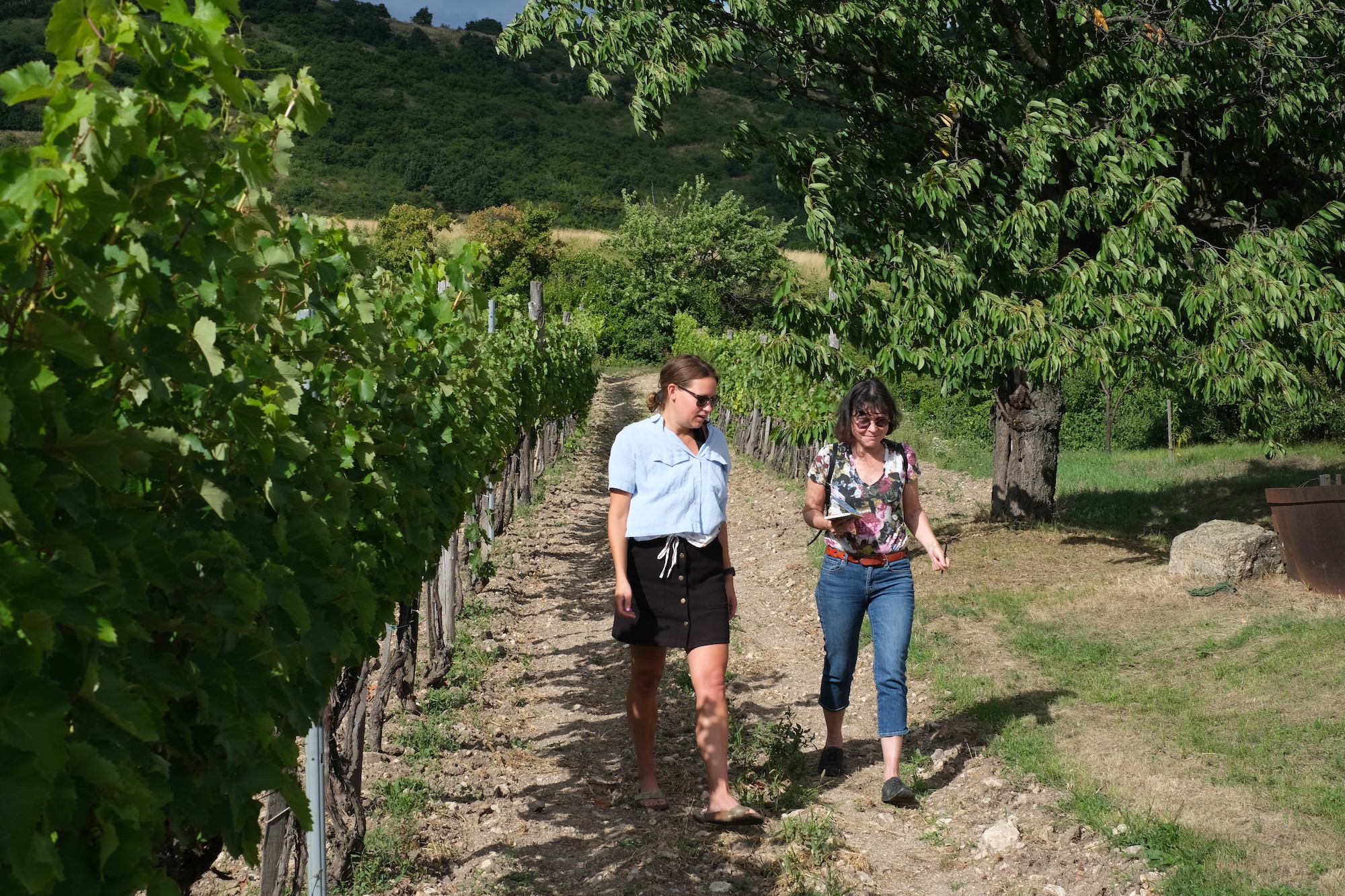
Catherine and Dorka walking in the Dongó vineyard
The Dongó (Bumble Bee) vineyard is Dorka’s favorite running spot. Tucked up in the northwest part of Tállya, it’s also a 1st Class Dűlő from the historical classification in the early 1700s and is mentioned in writing as early as 1561. The bedrock is rhyolite with quite a bit of detritus. Dorka grows both Furmint and Hárslevelű here and the fruit goes to both dry and skin contact wines.
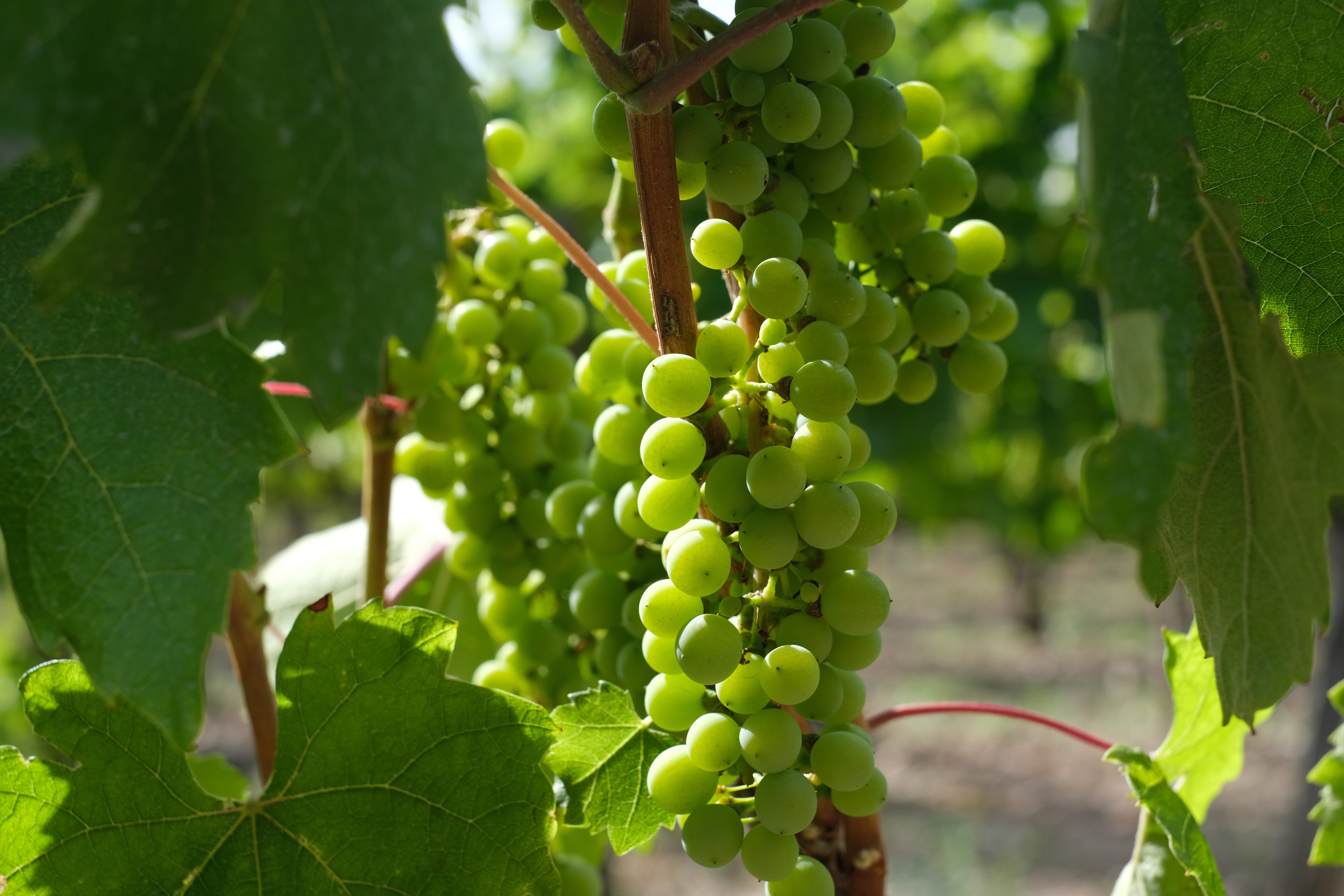
Hárslevelű grape
The Hetény Dűlő is also mostly Rhyolite but with much more clay and a little bit of loess as well. First mentioned as early as 1298, this is quite a heralded location. Furmint and Hárslevelű dominate the plantings and the clay and better water retention yield really bright acidity. This is one of the ideal sites for her sparkling wines.
The Nyergesek Dűlő (saddle vineyard) produces bright fruit with often hard acidity. The acidity is so sharp from the andesite heavy soils that it needs to be tamed by either maceration, sugar and or age. First mentioned in 1469, this is mixture of Furmint and Hárslevelű and is ideal for her sparkling wines.
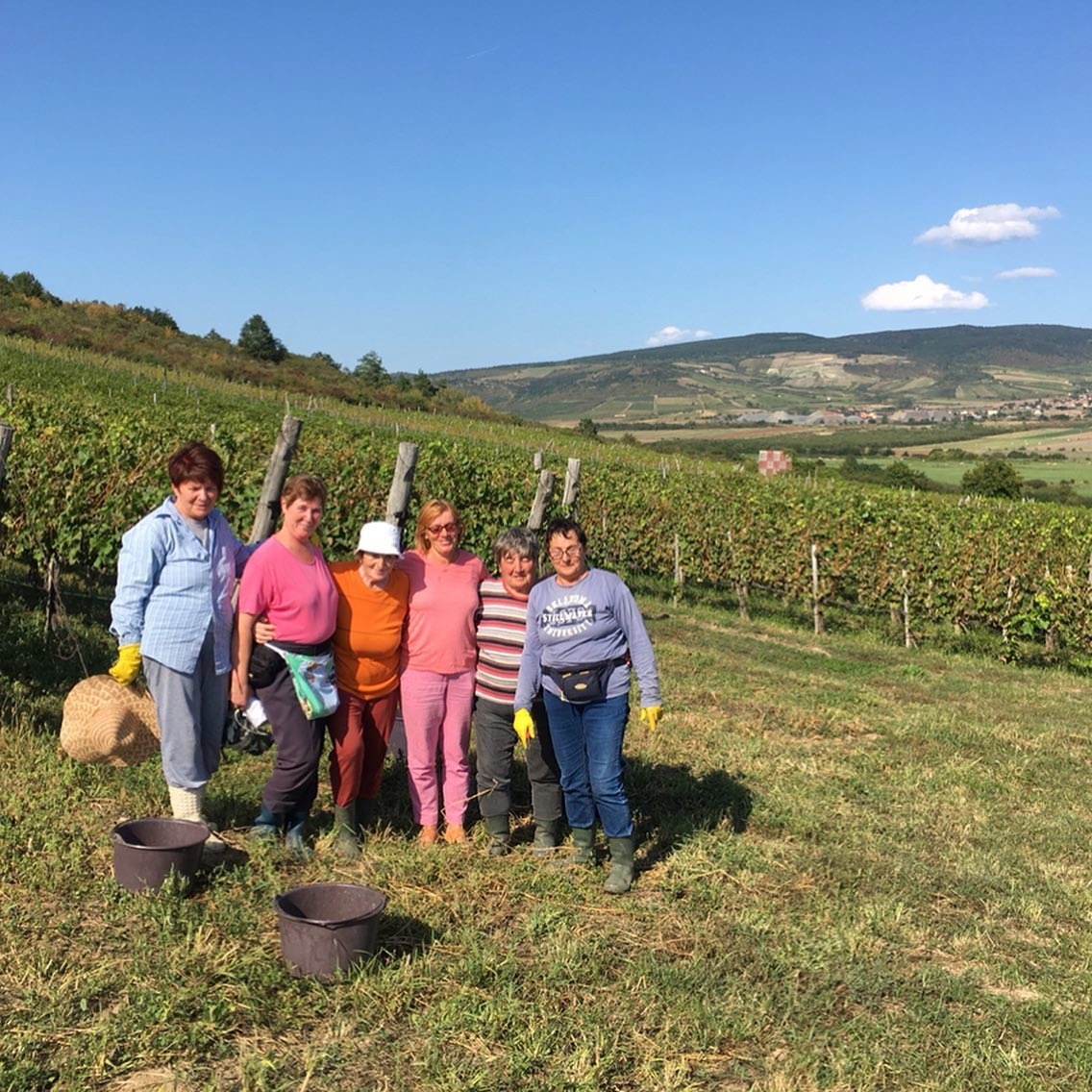
The harvest crew at Homoky Dorka
The Sas alja Dűlő translates to the “bottom of the eagle” and most likely comes from Szász (aka Saxon) but written in the Latin form of ‘Sas.’ Not sure what the take away from either is, but the andesite bedrock here produces, as Dorka puts it, “dense character.” Planted to both Furmint and Hárslevelű, the aromatics jump out in a very non Muscat way, the acidity is well balanced, and is unlike any other dry Tokaj in the whole portfolio.
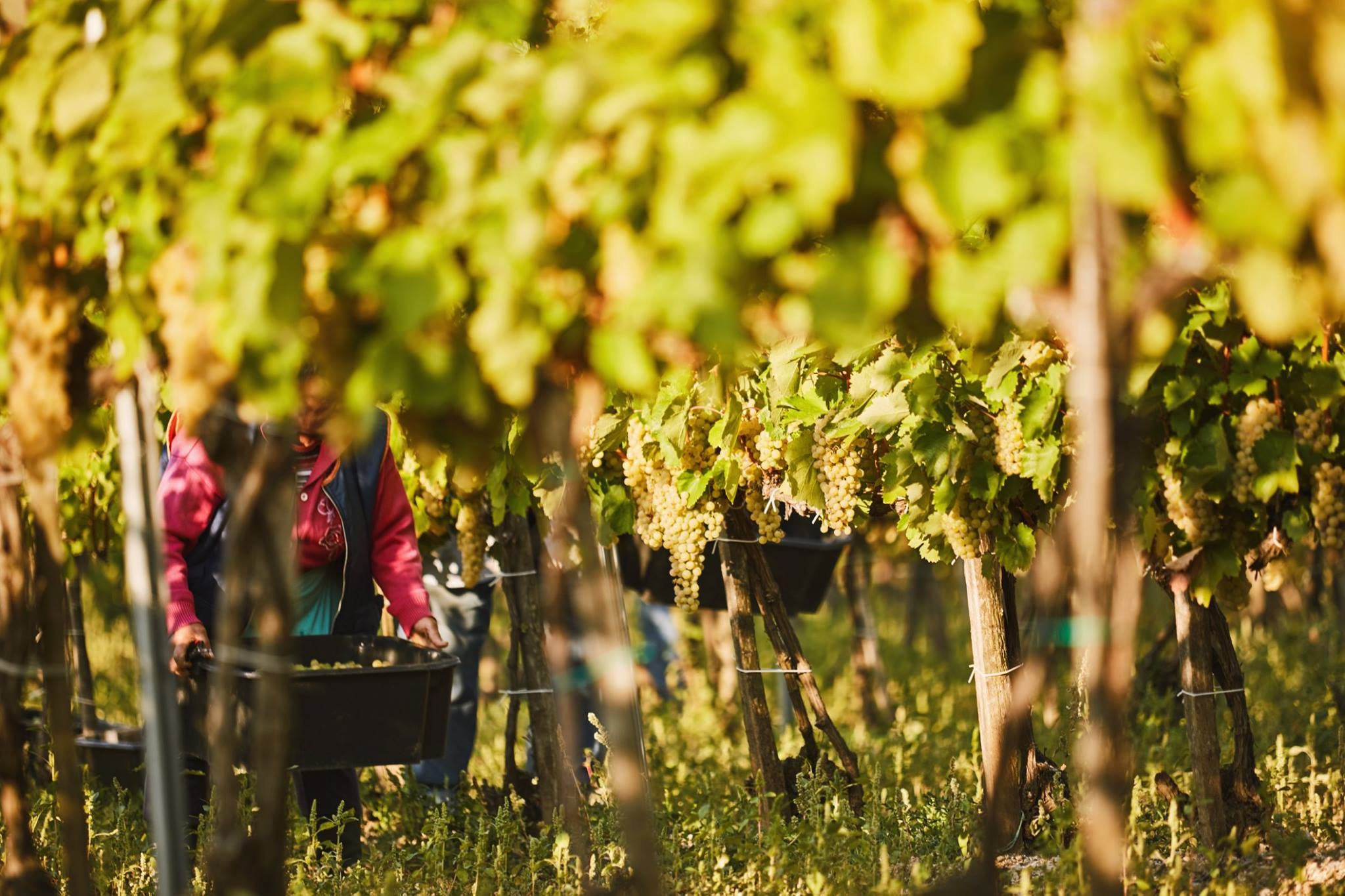
Harvest at Homoky Dorka
The Bártfai Dűlő falls along the northern end of the andesite mountain range. This is more or less dedicated to Furmint and is incredibly noticeable as a distinct site across multiple vintages. Tons of structure, the acidity doesn’t dominate as often can with Furmint, and there’s probably good reason written accounts of this vineyard date back to 1487.
According to the historical classification system, the Görbe Dűlő is another first-class area and was first mentioned was in 1644. The bedrock is rhyolite with a healthy layer of mixed volcanic clay as well. Super distinct on it’s own with some age, it also grows most of her Sargamuskotály as well.
Like the rest of Tokaj, the soils here are heavily volcanic. In this southwestern corner of the appellation, andesite dominates many of the sites along with ryholite and a few pockets or loess typically only found around the villages of Tokaj and Tarcal.

Catherine and Dorka walking in the Dongó vineyard
The Dongó (Bumble Bee) vineyard is Dorka’s favorite running spot. Tucked up in the northwest part of Tállya, it’s also a 1st Class Dűlő from the historical classification in the early 1700s and is mentioned in writing as early as 1561. The bedrock is rhyolite with quite a bit of detritus. Dorka grows both Furmint and Hárslevelű here and the fruit goes to both dry and skin contact wines.

Hárslevelű grape
The Hetény Dűlő is also mostly Rhyolite but with much more clay and a little bit of loess as well. First mentioned as early as 1298, this is quite a heralded location. Furmint and Hárslevelű dominate the plantings and the clay and better water retention yield really bright acidity. This is one of the ideal sites for her sparkling wines.
The Nyergesek Dűlő (saddle vineyard) produces bright fruit with often hard acidity. The acidity is so sharp from the andesite heavy soils that it needs to be tamed by either maceration, sugar and or age. First mentioned in 1469, this is mixture of Furmint and Hárslevelű and is ideal for her sparkling wines.

The harvest crew at Homoky Dorka
The Sas alja Dűlő translates to the “bottom of the eagle” and most likely comes from Szász (aka Saxon) but written in the Latin form of ‘Sas.’ Not sure what the take away from either is, but the andesite bedrock here produces, as Dorka puts it, “dense character.” Planted to both Furmint and Hárslevelű, the aromatics jump out in a very non Muscat way, the acidity is well balanced, and is unlike any other dry Tokaj in the whole portfolio.

Harvest at Homoky Dorka
The Bártfai Dűlő falls along the northern end of the andesite mountain range. This is more or less dedicated to Furmint and is incredibly noticeable as a distinct site across multiple vintages. Tons of structure, the acidity doesn’t dominate as often can with Furmint, and there’s probably good reason written accounts of this vineyard date back to 1487.
According to the historical classification system, the Görbe Dűlő is another first-class area and was first mentioned was in 1644. The bedrock is rhyolite with a healthy layer of mixed volcanic clay as well. Super distinct on it’s own with some age, it also grows most of her Sargamuskotály as well.
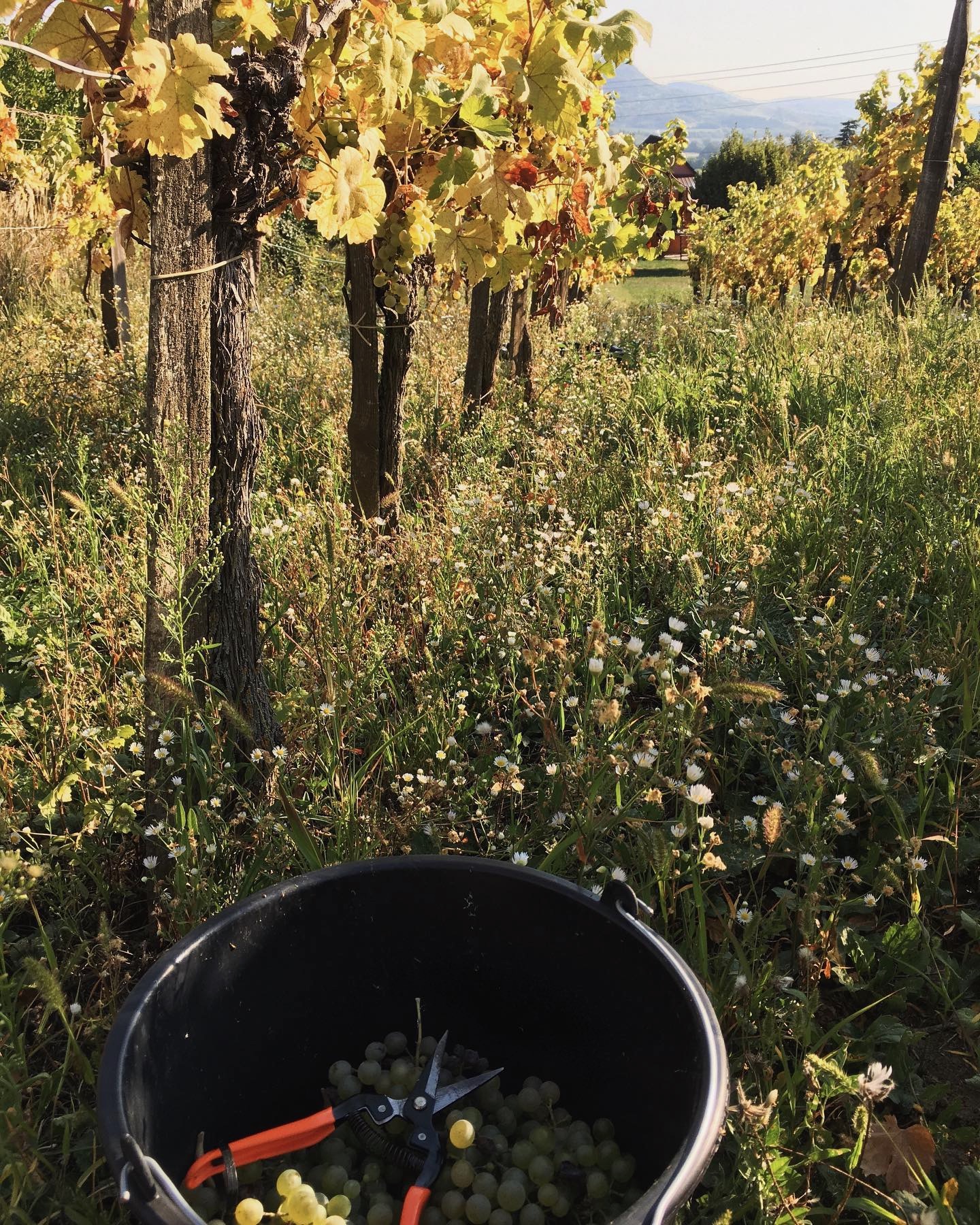
Harvest 2021 at Homoky Dorka

Harvest 2021 at Homoky Dorka
Winemaking
All grapes are hand harvested, destemmed and then pressed without crushing. Most lots are spontaneously fermented in stainless steel, then aged further on the lees in stainless along with shorter élevage in barrel due to most of her barrels being so young. All wines are bottled without filtering or fining and the only addition is SO2.

White Wine
Furmint;
13.3%
0.4 g/l
6.4 g/l
Furmint;
13.3%
0.4 g/l
6.4 g/l
This is only the second vintage of making this wine with zero additions. It also threw some new curveballs as well. The vintage was hot and low yielding – 50% down from the previous year. Made during the peak of COVID in Hungary, this is a vineyard where Dorka would run often to clear her head. Whole cluster pressed, fermented in tank and aged in barrel, it has very ripe end of season flavors, but still incredibly fresh and light on its feet. We can’t wait to open a bottle in a few years and see what’s happening inside.

White Wine , Organic
Hárslevelű; Furmint;
13%
0.5 g/l
13.65 g/l
Hárslevelű; Furmint;
13%
0.5 g/l
13.65 g/l
This is a blend of 70% Hárslevelű and 30% Furmint from the Dongó and Nyergesek vineyards. Picked earlier than the single vineyard versions, all of the grapes were pressed without crushing or destemming, and then fermented in both stainless steel and egg on the lees. Like most estate wines, this is taking the temperature of the vintage but also hinting at the built in reductive notes that really focus on the salt, smoke and acidity of Tokaj. The andesite heavy Nyergesek vineyard brings acidity and structure while the Dongó is dominated by rhyolite soils lending the salt and smoke. This is such a different side of Tokaj both in terms of being far from the rivers and marshes, but also given the absence of added sulfur, how it balances the acidity of the region without residual sugar and or botrytis.

White Wine
Furmint;
13%
0.4 g/l
7.8 g/l
Furmint;
13%
0.4 g/l
7.8 g/l
Whereas the Hetény is used for both sparkling and fresh wines, the Dongó (Bumble Bee) is ideal for both fresh wines and extended macerations. Tucked up in the northwest part of Tállya, it’s a 1st Class Dűlő from the historical classification in the early 1700s and is mentioned in writing as early as 1561. The bedrock is rhyolite with quite a bit of detritus. It’s also Dorka’s favorite running spot. Hand harvested at the end of September, the 2021 was whole cluster pressed and fermented in stainless steel. Bottled without fining or filtering, it’s also not stirred beforehand. While the 2020 was rich and more turbid texture wise, this has an intense built in reduction and concentration and that is both undeniably salty Tokaj, but also without any added SO2, something really special.
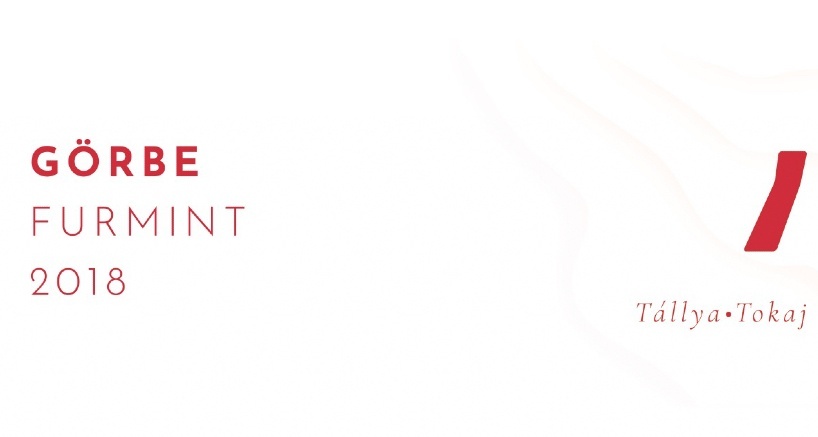
White Wine
Furmint;
14.1%
1.2 g/l
5.2 g/l
Furmint;
14.1%
1.2 g/l
5.2 g/l
Dorka hated this wine at first and admitted to feeling a little detached from it. Still working on her diploma, she worked the 2019 harvest in New Zealand and left much of the work to her parents. The vintage was hot, yields were low, and even with 2 months in barrel to soften things out, it was difficult to understand it when she returned home. Turns out that this site just needs some time in bottle and time opened as well. She’s come around to love it and also makes a skin-fermented Muscat from the site as well. For us, it’s like walking into a thermal spa in Budapest. Thick sodium rich soft water spiked with sweet spices and refreshing Tokaji acidity.

White Wine , Organic
Furmint; Hárslevelű;
13.7%
0.5 g/l
7 g/l
Furmint; Hárslevelű;
13.7%
0.5 g/l
7 g/l
The Hetény Dűlő, first mentioned in 1298, is in the southwest corner of Tállya and has a cooler east facing disposition. Mostly Rhyolite but with much more clay and a little bit of loess, this site throws a lot of acidity, even for Tokaj. Not surprisingly, this is the largest fruit source for her sparkling production. The wine was pressed without destemming or crushing, fermented and aged in stainless steel, and bottled unfined/unfiltered with around 10ppm total SO2. Acidity here is straight as an arrow and goes on and on. Analytically speaking, the numbers are nearly identical to that of 2019, but this wine could not be more different. Pungent and elegant, this is becoming one of the core wines for us.

White Wine , Organic
Furmint; Hárslevelű;
13.5%
0.4 g/l
7.46 g/l
Furmint; Hárslevelű;
13.5%
0.4 g/l
7.46 g/l
The Hetény Dűlő, first mentioned in 1298, is in the southwest corner of Tállya and has a cooler east-facing disposition. You can see over to Mt. Tokaj, and the villages of Tállya and Mád on a clear day. Mostly Rhyolite but with much more clay and a little bit of loess, this site throws a lot of acidity, even for Tokaj. Not surprisingly, this is the largest fruit source for her sparkling production. The 2021 was 70% Furmint, 30% Hárslevelű and all pressed without destemming or crushing. It was then fermented and aged half in stainless steel and half in barrel. Compared to the 2020, this was not stirred up before being bottled unfined/unfiltered. There is less of an oxidative and leesy quality, and instead geared more towards tension and freshness.

Sparkling Wine , Organic
Furmint; Hárslevelű;
12.9%
4.5 g/l
6.12 g/l
Furmint; Hárslevelű;
12.9%
4.5 g/l
6.12 g/l
This is roughly 60% Furmint and 40% Hárslevelű from the Dongó, Hetény and Nyergesek vineyards. Spontaneously fermented in stainless steel and then bottled with 12 g/l residual sugar. Bottled without disgorgement, there’s a lot happening in this bottle. Definitely give a proper chill and expect a little extra excitement at opening. Nothing in terms of major loss, but have a glass ready as a little with froth over the top. Tokaj isn’t lost in the pét-nat-ness, but it’s very similar to barrel tasting in Tokaj if you then added the alcohol and acidity of a finished wine. This is only her second commercial release and among the very first pét-nats from Tokaj to reach the US market.

Sparkling Wine , Organic
Furmint;
13%
21.6 g/l
6.12 g/l
Furmint;
13%
21.6 g/l
6.12 g/l
This is a 100% traditional method sparkling Furmint from the famed Kővágó vineyard. Mentioned as far back as 1349, this is a colder site on super rhyolite heavy rocky (Kővágó = Stonecutter) soils. It’s later ripening and maintains incredibly high acidity. It was first disgorged in December 2020 and then left to rest for 6 months. While this is classified as an Extra Dry, it reads far drier and like much of Tokaj, needs the extra residual sugar to coax out the volcanic fruit and tame the acidity. Only 600 bottles produced.

White Wine , Organic
Hárslevelű;
14.7%
1.4 g/l
5.2 g/l
Hárslevelű;
14.7%
1.4 g/l
5.2 g/l
The Sas alja Dűlő translates to the “bottom of the eagle” and most likely comes from Szász (aka Saxon) but written in the Latin form of ‘Sas.’ Not sure what the take away from either is, but the andesite bedrock and rich clay here produces, as Dorka puts it, “dense character.” Its first mention dates back 1622. The 2019 was pressed without destemming or crushing, fermented and aged in stainless steel, and bottled unfined/unfiltered with around 10ppm total SO2. Hárslevelű typically has less acidity than Furmint, which is true here, but it doesn’t come across as such. The aromatics jump out in a very non Muscat way, the alcohol doesn’t come across as hot at all, the weight is creamy without any residual sugar, super salty as it opens up, and it’s quite simply unlike any other dry Tokaj in the whole portfolio.